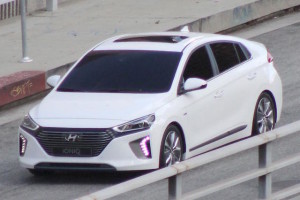
South Korea’s Hyundai will this month reveal its new petrol-electric Ionig, the first in a line of hybrid vehicles it plans as part of its aim to challenge Toyota as the motoring industry’s global green leader.

And the Ioniq isn’t the only vehicle Hyundai will use to muscle in on Toyota territory – it appears the Santa Cruz ute concept it unveiled at the Detroit show this time last year is likely to be given the go-ahead for production.
Such a decision would please Hyundai NZ general manager Andy Sinclair, who has said many times that he would welcome the addition of a ute to compete against the likes of the Toyota Hilux, Ford Ranger and company.
Hyundai HQ in Seoul is well aware of the strength of ute sales in NZ and Australia, but whether it would build both left- and right-hand variants right off the bat is another question.

Hyundai’s North American planning chief Mike O’Brien told reporters in the USA that 18 months of preparation have already gone into the business case for the Santa Cruz, codenamed HCD-15 as a concept.
“The engineering feasibility work has been done … we’re very anxious to do something with the idea,” said O’Brien.
A production model Santa Cruz would likely share its underpinnings with the Tucson SUV. Hyundai sells around 50,000 Tucsons each year in the US, and a Santa Cruz could help it double sales of the platform.
O’Brien hinted that Santa Cruz could be Hyundai’s first diesel model in the US. “The diesel is the most promising because of the fuel economy it delivers,” he said.

“It best matches in our research of what these customers are looking for … outstanding fuel economy, good torque and good driveability.”
Meanwhile, Hyundai’s Ioniq isn’t just another hybrid or Toyota Prius challenger – it is expected to be the world’s first production car with fully electric, hybrid and plug-in hybrid powertrain options in the range.
Said Woong-Chul Yang, Hyundai’s research and development chief: “Our vision for future mobility focuses on choice, with a variety of powertrain options to suit customers’ varied lifestyles, without compromising on design or driving enjoyment. Ioniq is the fruit of our efforts to become the leader in the global green car market.”
The Ioniq name is a combination of ‘ion’, an electrically charged atom, and ‘unique’. It is said to be pronounced ‘i-on-ic’, or ‘iconic’ without the ‘c’.
The hybrid is pictured here for the first time with a Hyundai camera car on a video shoot ahead of a special upcoming appearance in Seoul. In March, it will be unveiled at the Geneva motor show.
Hyundai has for some time shown stylised teaser photos of the Ionic, saying it would offer “class-leading aerodynamic performance.” The photos here are evidence of its slippery shape.
The Ioniq is based on a new platform, specially developed, says Hyundai, to house the car’s lithium-ion batteries. The batteries in the hybrid variant will be charged by a 1.6-litre petrol engine.
- Hyundai continues to raid the ranks of elite automotive designers as it seeks to boost global growth. It has just hired former Lamborghini design chief Manfred Fitzgerald to run its luxury Genesis brand. Fitzgerald will work on Genesis with another newcomer to South Korea, former Bentley design boss Luc Donckerwolfe. Both men will answer to Peter Schreyer, Hyundai’s chief designer and a former VW Group executive. Also in the mix is another relative Hyundai rookie, Albert Biermann, once the engineering head of BMW’s ‘M’ division.
